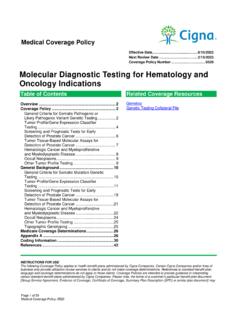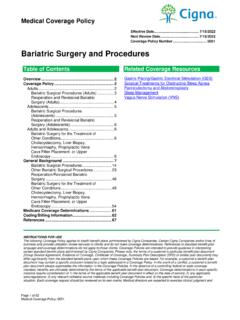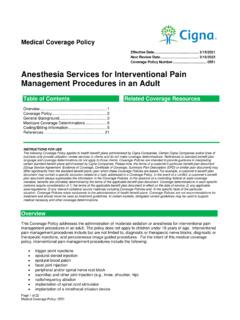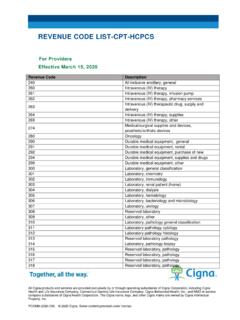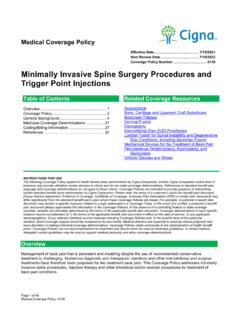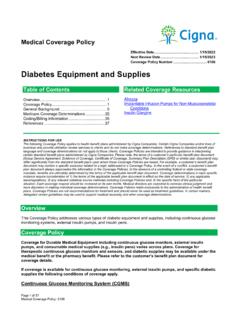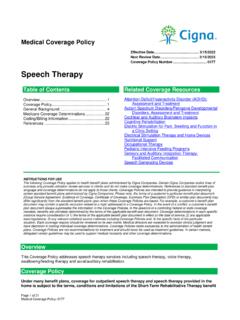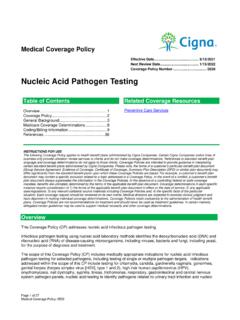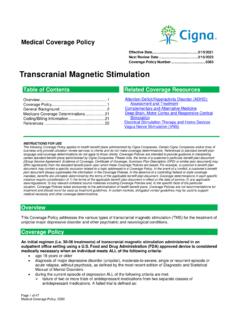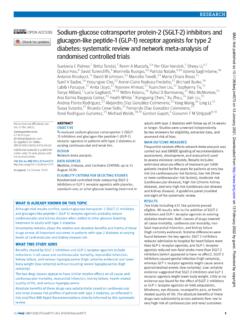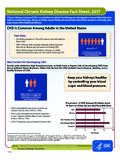Transcription of Vitamin D Testing - Cigna
1 Medical Coverage Policy Effective Date .. 3/15/2021. Next Review 3/15/2022. Coverage Policy Number .. 0526. Vitamin D Testing Table of Contents Related Coverage Resources Overview ..1. Coverage Bone Mineral Density Measurement General Background ..2 Preventive Care Services Testing Literature Review ..3. Testing Professional Societies ..3. Supplementation Literature Review ..7. Supplementation Professional Societies ..9. Medicare Coverage Determinations .. 11. Appendix A .. 12. Coding/Billing Information .. 12. References .. 18. INSTRUCTIONS FOR USE. The following Coverage Policy applies to health benefit plans administered by Cigna Companies. Certain Cigna Companies and/or lines of business only provide utilization review services to clients and do not make coverage determinations.
2 References to standard benefit plan language and coverage determinations do not apply to those clients. Coverage Policies are intended to provide guidance in interpreting certain standard benefit plans administered by Cigna Companies. Please note, the terms of a customer's particular benefit plan document [Group Service Agreement, Evidence of Coverage, Certificate of Coverage, Summary Plan Description (SPD) or similar plan document] may differ significantly from the standard benefit plans upon which these Coverage Policies are based. For example, a customer's benefit plan document may contain a specific exclusion related to a topic addressed in a Coverage Policy.
3 In the event of a conflict, a customer's benefit plan document always supersedes the information in the Coverage Policies. In the absence of a controlling federal or state coverage mandate, benefits are ultimately determined by the terms of the applicable benefit plan document. Coverage determinations in each specific instance require consideration of 1) the terms of the applicable benefit plan document in effect on the date of service; 2) any applicable laws/regulations; 3) any relevant collateral source materials including Coverage Policies and; 4) the specific facts of the particular situation. Coverage Policies relate exclusively to the administration of health benefit plans.
4 Coverage Policies are not recommendations for treatment and should never be used as treatment guidelines. In certain markets, delegated vendor guidelines may be used to support medical necessity and other coverage determinations. Overview This Coverage Policy addresses serum Vitamin D Testing . Coverage Policy Vitamin D Testing is considered medically necessary in a non-pregnant individual age 18 64 years for any of the following: condition or medical diagnosis associated with Vitamin D deficiency (See Appendix A). previously documented Vitamin D deficiency known or suspected excessive Vitamin D blood levels ( , toxicity). Page 1 of 23. Medical Coverage Policy: 0526.
5 Vitamin D Testing for any other indication including screening in the general population is considered not medically necessary. Vitamin D Testing (CPT 82306) more frequently than twice in 12 rolling months is considered not medically necessary for any diagnosis other than chronic kidney disease (CKD) or intestinal malabsorption. Vitamin D Testing utilizing both CPT 82306 and CPT 82652 in combination is considered not medically necessary. General Background Vitamin D is a fat-soluble Vitamin . Very few foods naturally contain Vitamin D (fatty fish and eggs are the exception), so Vitamin D is obtained primarily through fortified foods or supplements and dermal synthesis from exposure to sunlight.
6 Vitamin D has two forms, ergocalciferol ( Vitamin D2) and cholecalciferol ( Vitamin D3), and several metabolites. Estimates of Vitamin D requirements vary and depend in part upon sun exposure and the standards used to define a deficient state. In 2010, the Institute of Medicine (IOM) released a report on dietary intake requirements for calcium and Vitamin D. Once an individual has been shown to be Vitamin D deficient, further Testing may be indicated only to ensure adequate replacement has been accomplished. 25(OH)D and 1,25(OH)2D. Vitamin D from the diet or dermal synthesis is biologically inactive and requires enzymatic conversion to active metabolites. Vitamin D is converted enzymatically: in the liver to 25-hydroxyvitamin D (25[OH]D), the major circulating form of Vitamin D; and then in the kidney to 1,25-dihydroxyvitamin D (1,25[OH]2D), the active form of Vitamin D.
7 The concentration of 25(OH)D is almost 1000-fold that of 1,25(OH)2D, and the half-life of 25(OH)D is much longer, implying that its concentration is more stable. The most common type of Vitamin D deficiency is 25-OH Vitamin D. A much smaller percentage of 1, 25- dihydroxy Vitamin D deficiency exists; mostly, in those with renal disease. Although it is not the active form of the hormone, 25-OH Vitamin D is more commonly measured. It better reflects the sum total of Vitamin D produced endogenously and absorbed from the diet than does the level of the active hormone 1, 25-dihydroxy Vitamin D. Deficiency of 1, 25-dihydroxy Vitamin D, which is present at much lower concentrations, does not necessarily reflect deficiency of 25-OH Vitamin D.
8 Its measurement should be limited to specific diseases such as acquired and inherited disorders in the metabolism of 25(OH)D and phosphate, including chronic kidney disease. 25(OH)D (CPT code 82306). The best laboratory indicator of Vitamin D adequacy is the serum 25(OH)D concentration. It is the measurement of choice to diagnose Vitamin D deficiency and to assess Vitamin D status. The lower limit of normal for 25(OH)D levels varies depending on the geographic location and sunlight exposure of the reference population. There is no consensus on the optimal 25(OH)D concentration for skeletal or extraskeletal health. The IOM. concluded that a serum 25(OH)D concentration of 20 ng/mL (50 nmol/L) is sufficient for most individuals.
9 Other experts (Endocrine Society, national Osteoporosis Foundation, and American Geriatrics Society) suggest that a minimum level of 30 ng/mL (75 nmol/L) is necessary in older adults to minimize the risk of falls and fracture. Additionally, 25(OH)D measurements have had wide spread variation in the results. Serum 25-OH-D assays fall into two main categories: (1) those based on a separation step of chromatography, the most popular of which is liquid chromatography tandem mass spectrometry (LC-MS/MS) and (2) nonchromatographic methods based on antibody or protein binding, such as radioimmunoassays. Serum 25(OH)D should be assessed in persons at risk for Vitamin D deficiency or insufficiency.
10 Vitamin D. deficiency may result from: inadequate exposure to sunlight or intake of Vitamin D. reduced absorption of Vitamin D ( , malabsorption* syndromes). medications or disorders that affect the metabolism of Vitamin D and phosphate ( , glucocorticoids, chronic kidney disease). Page 2 of 23. Medical Coverage Policy: 0526. resistance to the effects of Vitamin D. *Causes of malabsorption may include: diseases of the gallbladder, liver, or pancreas some conditions such as cystic fibrosis damage to the intestine from infection, inflammation, trauma, or surgery parasitic diseases certain congenital defects such as biliary atresia Vitamin D Toxicity: Another reason to measure serum 25(OH)D is when there is a suspicion of excessive Vitamin D blood levels (toxicity).
